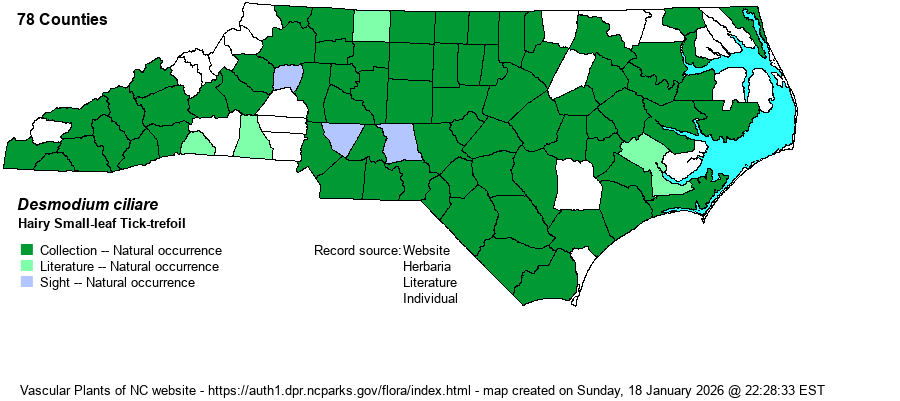| Section 6 » Order Fabales » Family Fabaceae |
Show/Hide Synonym
| taxonName | relationship | relatedTaxonName | relatedTaxonRefText | relComments |
|---|
|
|
|
|
|
|
|
|
|
|
|
|
|
|
| Desmodium ciliare | > | Desmodium ciliare var. ciliare | Fernald (1950) | | | Desmodium ciliare | > | Desmodium ciliare var. ciliare | | | | Desmodium ciliare | > | Desmodium ciliare var. lancifolium | Fernald (1950) | | | Desmodium ciliare | > | Desmodium ciliare var. lancifolium | | | | Desmodium ciliare | = | Desmodium marilandicum var. ciliare | Flora of North America (1993b, 1997, 2000, 2002a, 2002b, 2003a, 2004b, 2005, 2006a, 2006b, 2006c, 2007a, 2009, 2010) | | | Desmodium ciliare | = | Meibomia ciliaris | Small (1933, 1938) | | | Source: Weakley's Flora |
|
| Author | (Muhlenberg ex Willdenow) de Candolle | |
| Distribution | Statewide, and probably present in all 100 counties. This species (as well as many other Desmodium species) has been under-collected, with collection records for "only" around 70 counties.
This is a widespread species of the Eastern states, ranging from MA, southern MI, and KS, south to southern FL and central TX. | |
| Abundance | Common to very common in most of the Piedmont and Coastal Plain (except toward the coast); fairly common (at least) in the Piedmont foothills. Common in the southern Mountains, but scarce in the northern Mountains. | |
| Habitat | This species occurs in typical Desmodium places -- woodland borders, powerline clearings, old fields, and other brushy or edge habitats, usually in somewhat mesic soils. In the Sandhills it also occurs in fire-maintained Longleaf Pine-Wiregrass uplands, notably in loamy sols of bean dips. | |
| Phenology | Blooms from June to September, and fruits from August to October. | |
| Identification | This is a slender and typically unbranched Desmodium, growing to about 2 feet tall on average. Numerous alternate leaves (3 leaflets) come off the stem, with only a very short petiole, almost looking sessile at a distance. The stem is quite pubescent, an important identification character, to help separate it from D. marilandicum. These leaves are quite small, with each leaflet being elliptical and rounded at the tip, only about 2/3-inch long, the lateral ones slightly smaller. At the top of the stem grow a handful of many-flowered racemes (perhaps also called a loose panicle) of bright rosy-pink flowers, but each is barely 1/5-inch long. The only other Desmodium to confuse with it is D. marilandicum, but that species has quite a bit longer petioles (often 2/3-inch long or more), the stem is glabrous or barely pubescent, and the leaflets are also essentially glabrous. Note that these two species look a bit like several Lespedeza species; however, members of that genus have small stipules at the base of the petiole where it joins the stem; Desmodium species have no stipules where a petiole attaches to a stem. All Desmodium species have the well-known "beggar's-ticks" or "beggar's-lice" seed pods, which break off and attach to clothing. Most species do have distinctive pods (number, shape, etc.), but many or most Desmodium species can be identified without them. This is a frequently seen Desmodium in the field, in fact it may be the most often encountered one on many a walk along a wooded edge or in a weedy powerline clearing. Look for the unbranched and hairy stem, and the small and nearly sessile leaves (but with no stipules present). | |
| Taxonomic Comments | Some references list varieties, but Weakley (2018) does not.
| |
| Other Common Name(s) | Little-leaf Tick-trefoil | |
| State Rank | S5 | |
| Global Rank | G5 | |
| State Status | | |
| US Status | | |
| USACE-agcp | | |
| USACE-emp | | |

